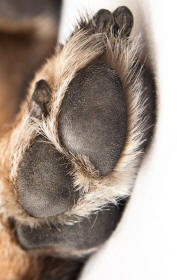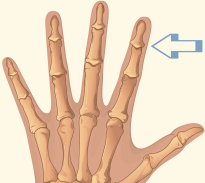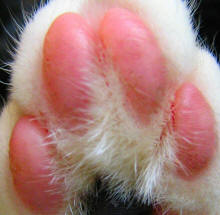Glossary

Pad
Cushion-like part of animal foot.
The tough, superficial cutis (outer layer of skin) of the pad is keratinized and hairless.
Under the cutis is the thick subcutis.
The fatty (adipose) tissue of the subcutis provides a cushion to absorb shock during locomotion.
The tough, superficial cutis (outer layer of skin) of the pad is keratinized and hairless.
Under the cutis is the thick subcutis.
The fatty (adipose) tissue of the subcutis provides a cushion to absorb shock during locomotion.
Digit
The distal parts of a limb, such as fingers or toes.
These are named and identified by Roman numerals.
In a pentadactyl (five-fingered or five-toed) arrangement, the most medial digit, if present, is I (e.g. the human thumb) and the most lateral is V (e.g. the human little finger).
These are named and identified by Roman numerals.
In a pentadactyl (five-fingered or five-toed) arrangement, the most medial digit, if present, is I (e.g. the human thumb) and the most lateral is V (e.g. the human little finger).
Distal Interphalangeal Joints
Hinge joints between the intermediate and the distal phalanges.


Dew Claw
Vestigial and rudimentary digit of the foot.
Some digitigrade animals, including dogs and cats, have dewclaws located on the medial (inner) side of the foot, (usually) too high up to make contact with the ground or register in a track.
Some digitigrade animals, including dogs and cats, have dewclaws located on the medial (inner) side of the foot, (usually) too high up to make contact with the ground or register in a track.
Title5
text
Title6
text
Title7
text
Title8
text
Title9
text






